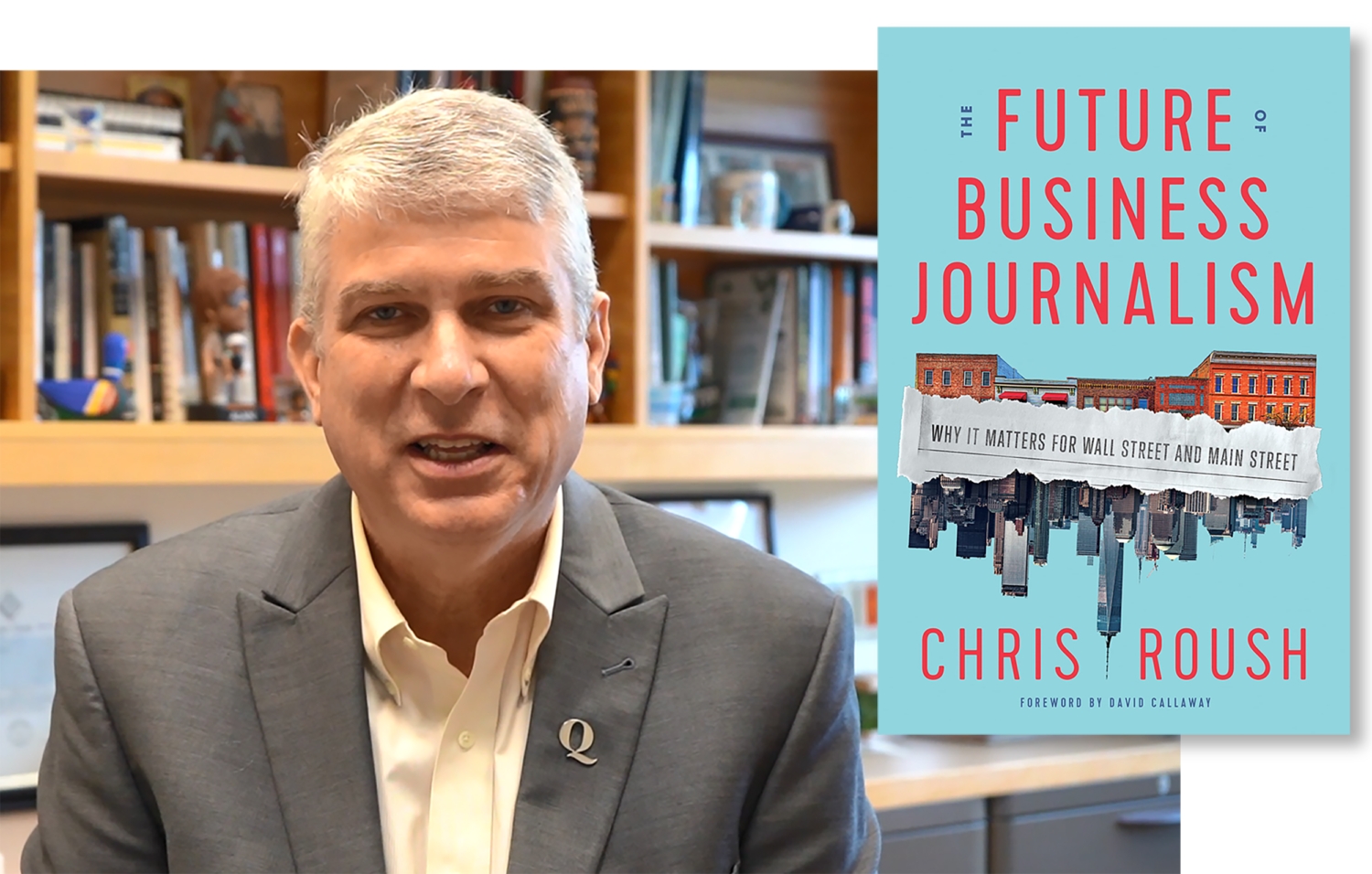This is an excerpt from “The Future of Business Journalism: Why it Matters to Wall Street and Main Street” by Quinnipiac University School of Communications dean Chris Roush.
When Toronto Globe and Mail retail reporter Marina Strauss began reporting in October 2016 about strategy changes at restaurant chain Tim Hortons, she requested interviews with the company’s chief executive officer and other management. The public relations staff told her that interviews would occur in late November. After interviewing a junior executive and some franchise owners, however, Strauss was denied any further interviews by the company’s public relations staff, who were upset with her asking about the executive’s age and family. The PR people told the newspaper that personal information was not allowed to be included in the story, according to Duncan Hood, the editor of the newspaper’s Report on Business magazine.
Tim Hortons canceled all further interviews, including one with the head of its store operations one hour before it was scheduled to start and with Strauss in her car on the way to the meeting. Strauss and the Globe and Mail published its story about the company anyway.
This is just one example of the fractured relationship between business journalists and the public relations people who represent businesses that often hurts coverage because a lack of cooperation can often lead to incomplete information. While many PR professionals have good working relationships with business reporters and editors and try to provide them with accurate and timely information about their companies, an increase in adversarial encounters has hurt what consumers, employees, and others know about important employers in their towns and cities. And it’s increasingly clear that public companies hire public relations staffers because company news moves their stock price, and they don’t want their price to go down.
For private companies, the hiring of public relations representatives helps them obtain a higher price when they sell to another company.
The battle between PR and business journalism is being won lately by a rise in public relations staffers, making them more common than the reporters who cover the companies they represent. According to the US Census Bureau, there were 6.4 public relations professionals for every journalist in the United States in 2018, up from 1.9 public relations staffers for every journalist just twenty years earlier. And between 2008 and 2017, US newsrooms—newspapers, television stations, and radio stations—cut 26,000 jobs, according to the US Department of Labor.
That disparity is likely to get worse—“employment of public relations specialists is projected to grow 7 percent from 2019 to 2029, faster than the [4 percent] average [growth] for all occupations,” according to the US Bureau of Labor Statistics. “Overall employment of reporters, correspondents, and broadcast news analysts is projected to decline 11 percent from 2019 to 2029,” according to the Bureau of Labor Statistics. Declining advertising revenue in radio, newspapers, and television will negatively affect the employment growth for these occupations.
The pay in public relations is also better than journalism, leading many reporters and editors to switch careers. According to the Pew Research Center, for every $1 in salary made by a public relations professional, a journalist makes just 65 cents.
The result is that companies are increasingly hiding behind their public relations staff, ignoring requests from business reporters for information and interviews, or going on the offensive and attempting to change the focus of a story or issuing statements to reporters that don’t answer the issues addressed in a reporter’s questions. Public relations professionals are now recommending that the companies they represent stop inviting business reporters to events such as annual investor meetings or simply refuse to talk with them. In some cases a public relations person will lie or obfuscate the truth. And public relations strategies now go directly to consumers and others by using social media such as Twitter to deliver company messages. They argue that using social media eliminates the filter of journalism, where reporters will only use the part of the message that they believe is important.
To be sure, that’s a reporter’s prerogative. But companies benefit in multiple ways from coverage in the media. By limiting interaction with the business news media, public relations professionals are, in the long run, hurting the companies who sign their paychecks. In the end, the truth about the company often comes out.
Take the case of KQED reporter Lily Jamali, who spent years covering Pacific Gas and Electric Company, a San Francisco–based company that struggled to overcome the perception that it was ignoring its customers after its equipment caused wildfires that burned forests and people’s homes. When the company offered some of its stock as part of a settlement and its public relations people said that was a common strategy, Jamali reviewed past cases and said, “It became clear to me that’s simply not true.” She also noted that the company was “reluctant” to have its executives talk to reporters. “The only opportunity to interview the CEO has been on the sidelines at regulatory or court hearings,” said Jamali, noting that those instances were limited during the COVID-19 pandemic, when the hearings went online.
Then there’s a situation facing many business journalists. Write a negative article about a business, and its public relations people might cut off access to executives or its response to simple questions. In Virginia, the state’s largest utility, Dominion Virginia Power, declined to talk to reporters from the Virginian-Pilot. It issued a statement to the newspaper saying that it has been the recipient of “inaccurate, biased and unfair news coverage and opinion pieces” from the newspaper.
Other public relations staffers will dangle exclusive interviews and stories in front of business reporters to get the journalist to drop another story that could portray their company in a negative light. When Fox Business News reporter Charles Gasparino was a reporter at the Wall Street Journal, he received a Merrill Lynch memo telling its brokers not to open accounts for less than $100,000, adding: “If you want to deal with poor people, you can get a nice job at the United Way.” When Gasparino contacted the company for his story about the memo, the PR person responded by saying, “What can we trade you not to write this story? You want an interview with our CEO?” Gasparino declined the request. But others may be swayed.
It’s easy to see why the relationship is so strained. Many business journalists feel as if public relations staff serve as a hindrance to their jobs. David Carr wrote in the New York Times: “Business reporters have to work their way past background conversations with underlings, written statements that state nothing, and that increasingly hardy perennial: the ‘no comment.’ The modern chief executive lives behind a wall of communications operatives, many of whom ladle out slop meant to obscure rather than reveal.”
Carr was being polite with the word “slop.” Public relations professionals are increasingly using lies and false and misleading information in their communications. In 2015 University of South Carolina professor Shannon Bowen, who researches public relations ethics, wrote that a study of public relations staffers discovered that a majority of them admitted to lying to the media on a regular basis. “And we wonder why journalists don’t trust PR sources, rate their ethics lower than that of journalists, and go around digging for other sources, more dirt, or even simple confirmation of facts?” she wrote.
Here’s an example of how this happens. Personal finance articles that appeared on CNBC’s website and in columns written by a Washington Post personal finance columnist quoted an “expert” in student loan refinancing. But the person quoted was a creation of the public relations staff of a student loan refinancing company. The “expert” had conducted e-mail interviews with journalists but didn’t exist.
To be sure, business reporters frequently turn to public relations professionals for help with stories. But, given the examples here and many others that were not included, it’s obvious that the relationship has been severely damaged and hurts how businesses are portrayed in the Media.
Corporate communications staff also must do a better job of training executives to understand that they play an important role in today’s society. That’s harder than it sounds, given that many executives have egos. “They are required to represent and communicate, but they are usually neither trained nor primarily chosen because of these aspects,” discovered Ansgar Zerfass and Markus Wiesenberg of the University of Leipzig and Dejan Verčič of the University of Ljubljana.
If you’re in public relations or believe that public relations staffers provide a valuable service to companies, don’t worry. Journalists do a lot wrong too when they cover business and economics: wooing CEOs and adopting their view in place of more reporting, overlooking good sources of data and story ideas, prioritizing Wall Street glamor ahead of Main Street information needs.
But that topic would be the stuff of another essay – or a book like the one I have written.







